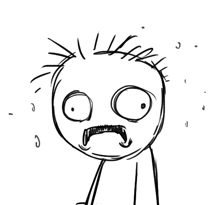Sign In
CloseSo here is the speculative creation of Aakedisss, a paleontologist, amateur artist and something of a dreamer descended from dinoavians on a world where the asteroid never hit and mammals remained small, scurrying, rodentlike creatures.
But what if they hadn’t? Aakedisss wonders. What if dinosaurs had gone extinct and mammals grew and diversified to take over their abandoned ecological niches? What if a mammal eventually even developed intelligence – what would it look like, this mammaloid?
The most obvious and striking difference between the mammaloid and her own species is, of course, the pelt of thick, soft fur (similar, but not identical to the pycnofibers covering pterosaurs). The coat is marked in dull shades of rust and grayish brown as, like many mammals, it is color-blind. The fur lacks the iridescent structures that give feathers their dazzle. It never even occurs to Aakedisss to make her mammaloid bare-skinned. She considers it likely to have evolved in Europe or the Americas after the winnowing and environmental pressures of a long Ice Age, and to have retained a full pelt like any other mammal.
It takes Aakedisss some time to figure out how to wrench the quadrupedal basic mammalian form upright. Eventually she recalls a small species of bipedal hopping desert rodent, and decides her mammaloid’s ancestors must have been something similar. Accordingly, she depicts it with powerful hind legs and a counterbalancing tail.
The head is, naturally, dominated by the massive domed skull. Mammal brains seem to be somewhat inefficient compared to dinoavian brains, and require more bulk for the same amount of processing power. The swollen skull limits the external ears’ motion, so they are reduced in size. Artistically, this appeals to Aakedisss as small ears give the mammaloid’s head a much more dinoavian (and therefore intelligent) aspect.
Less able to depend on its sharp mammalian hearing, the creature’s eyesight becomes more important, and its eyes are large and oriented forwards over its narrow muzzle. Aakedisss suspects they won’t bother re-evolving color vision, and that they will require a large surface area of retina to resolve clear images. The big, dark eyes end up giving it a rather charming expression.
It still has its ancestors’ pronounced snout and damp nose. Sense of smell is so important to mammals that Aakedisss assumes it will remain so. Perhaps their art forms and language are partly based on the emission of scents?
The mammaloid has narrow, sloping shoulders and a somewhat restricted range of motion in its forelimbs. In Aakedisss’s world, there are no brachiating mammals – for that matter, there are no brachiating dinosaurs. Her own mobile forelimbs are a gift from her flying ancestors, who freed them up for a few million years of flapping before becoming terrestrial once again. Aakedisss toys with the notion of giving her mammaloid a similar history of descent from batlike fliers, but eventually decides that’s too suspiciously coincidental.
To compensate, the mammaloid has developed the second and fourth fingers of its hand as thumbs. In most rodents the first digit is reduced in size, and Aakedisss thinks that it’s more likely for evolution to mold the second digit into a grasping thumb rather than to re-evolve the first digit. And after all, the dinoavians get along fine with just three digits (two fingers and a thumb) so five fingers would simply be superfluous.
It is a cliché of mammal art to always illustrate female specimens that are either giving birth to or nursing a litter of squirming young, but the mammalian method of reproduction is so bizarre and unique that most artists can’t resist emphasizing it. Aakedisss is aware of the cliché, but in this case feels it instructive to depict her mammaloid as a mother. She is convinced that it’s much more believable for a marsupial to develop intelligence, as a placental mammal would either have to evolve ridiculously wide hips to pass a large-brained infant, or give birth to it in such an undeveloped state it would have very little chance of survival.
Although Aakedisss’s speculative mammaloid is a darling of the press and the life-sized model exhibited in her museum is beloved by visiting schoolhatchlings, a small group of “mammal nerds” is vehemently critical of it, considering its design too conservative and dinosaur-like. They suggest a small, gregarious burrowing mammal with mobile tendrils on its nose would be more likely to develop these as a grasping organ, and tout their underground society of multitrunked, quadrupedal hive-mind mammaloids far more credible than Aakedisss’s creation.
Submission Information
- Views:
- 1065
- Comments:
- 1
- Favorites:
- 12
- Rating:
- General
- Category:
- Visual / Digital






Link
SiriusDF
I love your speculative worlds and mammaloid species.